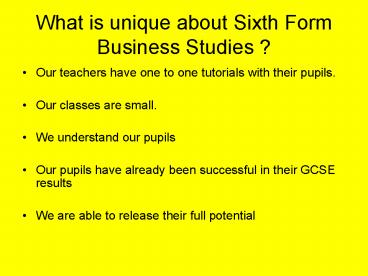What is unique about Sixth Form Business Studies PowerPoint PPT Presentation
1 / 24
Title: What is unique about Sixth Form Business Studies
1
What is unique about Sixth Form Business Studies ?
- Our teachers have one to one tutorials with their
pupils. - Our classes are small.
- We understand our pupils
- Our pupils have already been successful in their
GCSE results - We are able to release their full potential
2
What will you learn about?
- Business is changing business practices are
becoming more diverse. Today there are new paths
to success in business as well-trodden academic
routes. The image of the businessman or woman is
also transforming. Todays new entrepreneur may
not have been out of school for many months,
indeed, may not even have left. - Businesses are having to adapt to these pressures
and recruit ever more carefully. However,
students who can already demonstrate aptitude and
talent have an advantage. AS and A2 Business can
give learners a valuable head start.
3
2008 Business Results
- AS
- 25 Grade A
- 75 Grade A B
- 100 Grade A C
4
2008 Business Results
- A2
- 20 Grade A B
- 40 Grade A C
- 100 Grade A- D
5
(No Transcript)
6
(No Transcript)
7
(No Transcript)
8
(No Transcript)
9
What about the Business Course?
- Our year 10 and 11 business pupils follow the AQA
GCSE Business Course - Our year 12 and 13 follow a natural progression
onto the AQA GCE Business Course
10
- Getting Started with AS/A2
- GCE Applied Business
11
Outline
- Internal assessment at AS Level
- Illustrating assessment of Unit 1
- The demands of the externally-assessed AS units
- Internal assessment at A2 level
- Illustrating assessment of Unit 8
- The demands of the externally-assessed A2 units
12
Internal assessment at AS (1)
- Candidates are required to Produce a portfolio
of work which - a) Describes the background to the investigation
or practical activity (A01) - b) Produces outcomes from the investigation or
practical activity (A02) - c) Analyses research to inform the investigation
or practical activity (A03) - d) Demonstrates judgement in relation to the
investigation or practical activity (A04).
13
Internal assessment at AS (2)
- These are requirements and not separate tasks
within a portfolio - They cover the four assessment objectives
- A01 Knowledge, skills and understanding
- A02 Application of knowledge, skills and
understanding - A03 Research and analysis
- A04 Evaluation
- Each A0 is given a separate mark using levels of
response schemes
14
Interpreting the assessment grids
- The following diagram illustrates the
relationship between the four requirements
15
Unit 1 portfolio requirements (1)
- Each student should
- Provide a detailed description of the aims and
objectives of the business - Investigate a business which enables them to
research the three key components (marketing
activities, enterprise skills and teams) - Use concepts in context to the business being
investigated - Judgement to be based on how the business has
achieved its aims and objectives evaluating key
factors contributing to this.
16
Unit 1 portfolio requirements (2)
- DO NOT
- Use theory throughout the portfolio eg on teams
- Expect candidates to have equal coverage of the
three key components (marketing activities,
enterprise skills and teams)
17
The externally-assessed AS units (1)
- Common features between Units 3, 4 and 5
- Stepped level of difficulty
- Levels of response mark schemes
- Lowest level of response reserved for generic
knowledge and responses out of context - Specific questions targeting quality of written
communication (identified on front page of each
paper)
18
The externally-assessed AS units (2)
- Unit 3 Financial Planning and Monitoring
- 1 hour examination
- Pre-released material
- Research task 1 informs Q1 on paper
- Research task 2 informs Q4 on paper
19
Internal Assessment at A2
- Candidates are required to Produce a portfolio
of work which - A Explains the background to the investigation or
practical activity (A01) - B Produces outcomes from the investigation or
practical activity (A02) - C Analyses research to inform the investigation
or practical activity (A03) - D Demonstrates judgement and evaluation in
relation to the investigation or practical
activity (A04)
20
The Assessment Objectives
B (AO2)
D (AO4)
A (AO1)
Defining the purpose and parameters of the
proposal/plan
A developed proposal/plan
Demonstrating evaluation in relation to B
C (AO3)
Research and analysis needed to inform A, B and D
21
Unit 8 portfolio requirements (1)
- Each student should
- Construct and use SMART objectives
- Base their business plan on an organisation
(profit or not-for-profit business) which isnt
too complex or simplistic - Consider what-if scenarios and contingency
plans - Use concepts in context
22
Unit 8 portfolio requirements (1)
- Each student should
- Construct and use SMART objectives
- Base their business plan on an organisation
(profit or not-for-profit business) which isnt
too complex or simplistic - Consider what-if scenarios and contingency
plans - Use concepts in context
23
Unit 8 portfolio requirements (2)
- DO NOT
- Limit your candidates investigations to start-up
businesses candidates can investigate existing
businesses seeking to diversify - Allow candidates to investigate large scale
operations
24
The externally-assessed A2 units
- Unit 11 The Marketing Environment
- Unit 12 Managing People
- Unit 15 Financial Accounting for Managers
- All 1½ hour examinations
- All based on unseen material

